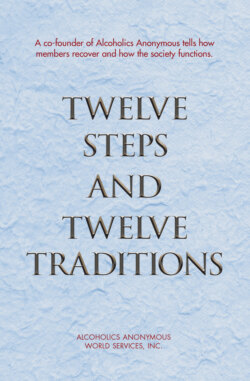Читать книгу Twelve Steps and Twelve Traditions - Anonymous - Страница 7
На сайте Литреса книга снята с продажи.
Foreword
ОглавлениеALCOHOLICS ANONYMOUS is a worldwide fellowship of more than one hundred thousand1 alcoholic men and women who are banded together to solve their common problems and to help fellow sufferers in recovery from that age-old, baffling malady, alcoholism.
This book deals with the “Twelve Steps” and the “Twelve Traditions” of Alcoholics Anonymous. It presents an explicit view of the principles by which A.A. members recover and by which their Society functions.
A.A.’s Twelve Steps are a group of principles, spiritual in their nature, which, if practiced as a way of life, can expel the obsession to drink and enable the sufferer to become happily and usefully whole.
A.A.’s Twelve Traditions apply to the life of the Fellowship itself. They outline the means by which A.A. maintains its unity and relates itself to the world about it, the way it lives and grows.
Though the essays which follow were written mainly for members, it is thought by many of A.A.’s friends that these pieces might arouse interest and find application outside A.A. itself.
Many people, nonalcoholics, report that as a result of the practice of A.A.’s Twelve Steps, they have been able to meet other difficulties of life. They think that the Twelve Steps can mean more than sobriety for problem drinkers. They see in them a way to happy and effective living for many, alcoholic or not.
There is, too, a rising interest in the Twelve Traditions of Alcoholics Anonymous. Students of human relations are beginning to wonder how and why A.A. functions as a society. Why is it, they ask, that in A.A. no member can be set in personal authority over another, that nothing like a central government can anywhere be seen? How can a set of traditional principles, having no legal force at all, hold the Fellowship of Alcoholics Anonymous in unity and effectiveness? The second section of this volume, though designed for A.A.’s membership, will give such inquirers an inside view of A.A. never before possible.
Alcoholics Anonymous began in 1935 at Akron, Ohio, as the outcome of a meeting between a well-known surgeon and a New York broker. Both were severe cases of alcoholism and were destined to become co-founders of the A.A. Fellowship.
The basic principles of A.A., as they are known today, were borrowed mainly from the fields of religion and medicine, though some ideas upon which success finally depended were the result of noting the behavior and needs of the Fellowship itself.
After three years of trial and error in selecting the most workable tenets upon which the Society could be based, and after a large amount of failure in getting alcoholics to recover, three successful groups emerged—the first at Akron, the second at New York, and the third at Cleveland. Even then it was hard to find two score of sure recoveries in all three groups.
Nevertheless, the infant Society determined to set down its experience in a book which finally reached the public in April 1939. At this time the recoveries numbered about one hundred. The book was called “Alcoholics Anonymous,” and from it the Fellowship took its name. In it alcoholism was described from the alcoholic’s point of view, the spiritual ideas of the Society were codified for the first time in the Twelve Steps, and the application of these Steps to the alcoholic’s dilemma was made clear. The remainder of the book was devoted to thirty stories or case histories in which the alcoholics described their drinking experiences and recoveries. This established identification with alcoholic readers and proved to them that the virtually impossible had now become possible. The book “Alcoholics Anonymous” became the basic text of the Fellowship, and it still is. This present volume proposes to broaden and deepen the understanding of the Twelve Steps as first written in the earlier work.
With the publication of the book “Alcoholics Anonymous” in 1939, the pioneering period ended and a prodigious chain reaction set in as the recovered alcoholics carried their message to still others. In the next years alcoholics flocked to A.A. by tens of thousands, largely as the result of excellent and continuous publicity freely given by magazines and newspapers throughout the world. Clergymen and doctors alike rallied to the new movement, giving it unstinted support and endorsement.
This startling expansion brought with it very severe growing pains. Proof that alcoholics could recover had been made. But it was by no means sure that such great numbers of yet erratic people could live and work together with harmony and good effect.
Everywhere there arose threatening questions of membership, money, personal relations, public relations, management of groups, clubs, and scores of other perplexities. It was out of this vast welter of explosive experience that A.A.’s Twelve Traditions took form and were first published in 1946 and later confirmed at A.A.’s First International Convention, held at Cleveland in 1950. The Tradition section of this volume portrays in some detail the experience which finally produced the Twelve Traditions and so gave A.A. its present form, substance, and unity.
As A.A. now enters maturity, it has begun to reach into forty foreign lands2. In the view of its friends, this is but the beginning of its unique and valuable service.
It is hoped that this volume will afford all who read it a close-up view of the principles and forces which have made Alcoholics Anonymous what it is.
(A.A.’s General Service Office may be reached by writing:
Alcoholics Anonymous, P.O. Box 459,
Grand Central Station, New York, NY 10163. U.S.A.)
1 In 2013, it is estimated that over two million have recovered through A.A.
2 In 2013, A.A. is established in approximately 170 countries.
